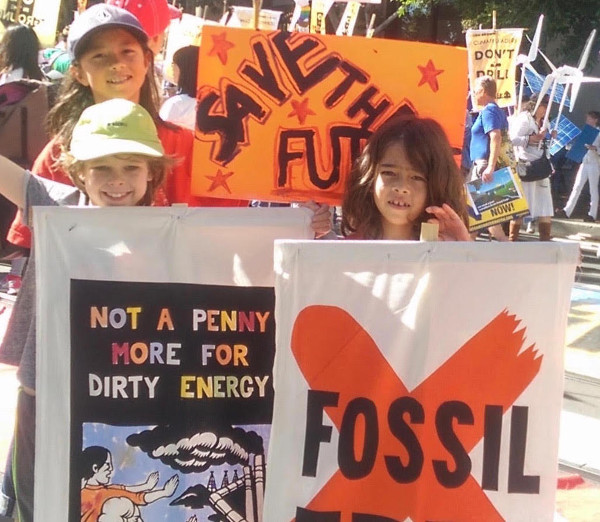
PHOTO/PEGGY ELWELL
On September 8, in the largest climate march ever on the West Coast, 30,000 marchers chanted “Keep It In the Ground” and “Oil Money Out, People Power In.” In this passionate display of will to save humanity and save the earth, the San Francisco marchers joined hundreds of thousands of protesters worldwide in more than 90 countries to demand action on climate change.
The Rise for Climate, Jobs and Justice March was the beginning of a packed week of protest in San Francisco surrounding the Global Climate Action Summit called by California Gov. Jerry Brown. The Summit, which was promoting market-based solutions, was forcefully challenged with civil disobedience by a thousand participants on opening day and teach-ins in the days preceding. Market measures like cap and trade, carbon offsets, and carbon taxes do not stop extraction nor cut emissions at the source.
Also that week, Gov. Brown signed SB 100, which mandates 100% renewable energy in California by 2045. Although passage of the bill is in one sense significant because California is the 5th largest economy in the world, it is too little too late and will not stem capitalism’s push for growth and profits which drives the climate crisis. Brown wants to be known for his environmental legacy, yet during his term in office California approved 20,000 oil extraction permits and refused to ban fracking (from which his family personally benefits).
Indigenous peoples and other communities impacted by climate injustice were represented from all over the western United States, marching at the head of the demonstration. Fifty to eighty percent of carbon left in the ground lies on and in native peoples’ lands. Casey Camp-Horinek of the Ponca Nation of Oklahoma described a toxic mix of refineries, injection wells and fracking by Phillips 66 and other fossil fuel extractors. Thirty injection wells are leaking methane into the local tribal drinking water sources. Every single family has a member with cancer, and they have been averaging a funeral a week.* Tom Goldtooth from the Indigenous Environmental Network spoke of building a movement, north and south, of people in struggle, African American, Latino, Asians, poor white folks, labor, and small farmers.*
Impacted communities in California include those ravaged by heat, fire, and the drought as well as oil. Cesar G. Aguirre, an organizer with the Central California Environmental Justice Network, said, “People in California’s Central Valley are forced to breathe some of the dirtiest air in the nation, and Kern County has the worst air in the U.S., because of toxic oil drilling. The climate crisis isn’t just happening in our atmosphere, it’s also happening in our bodies when we breathe this poisoned air.” *
The understanding of many in the environmental movement has evolved in recent times. This includes:
Placing at the forefront the voice of the most impacted communities, frequently indigenous, low-income and people of color;
Addressing the question of jobs, with a just transition to employment in renewable energy;
Recognition that a capitalist economy with its emphasis on profit and growth cannot save our people and planet, and that a cooperative economy is necessary to make our survival our priority.
* From media interviews by Amy Goodman and Christopher Cook
